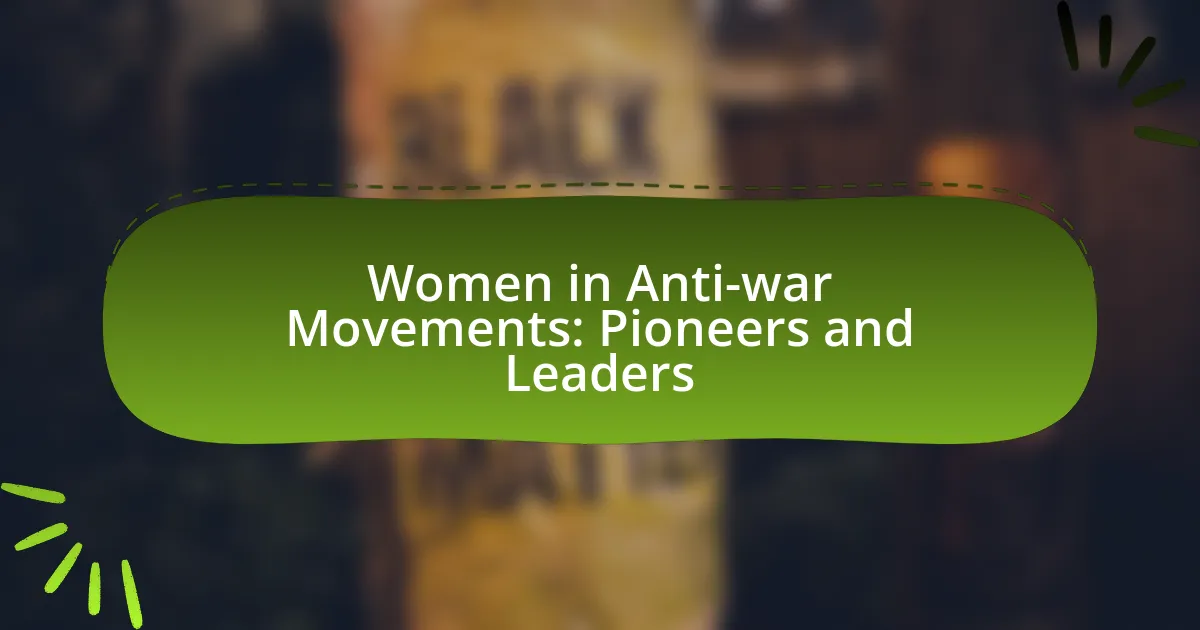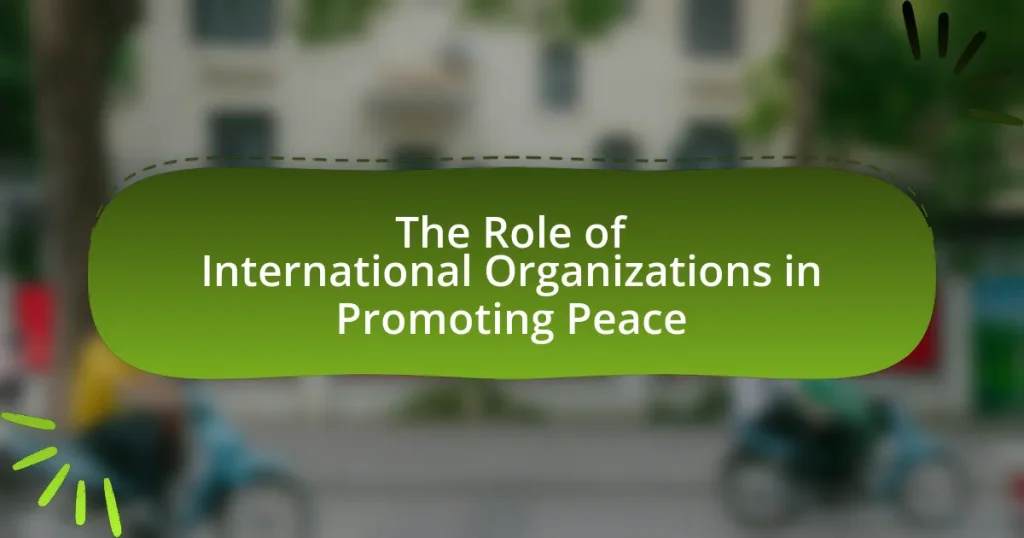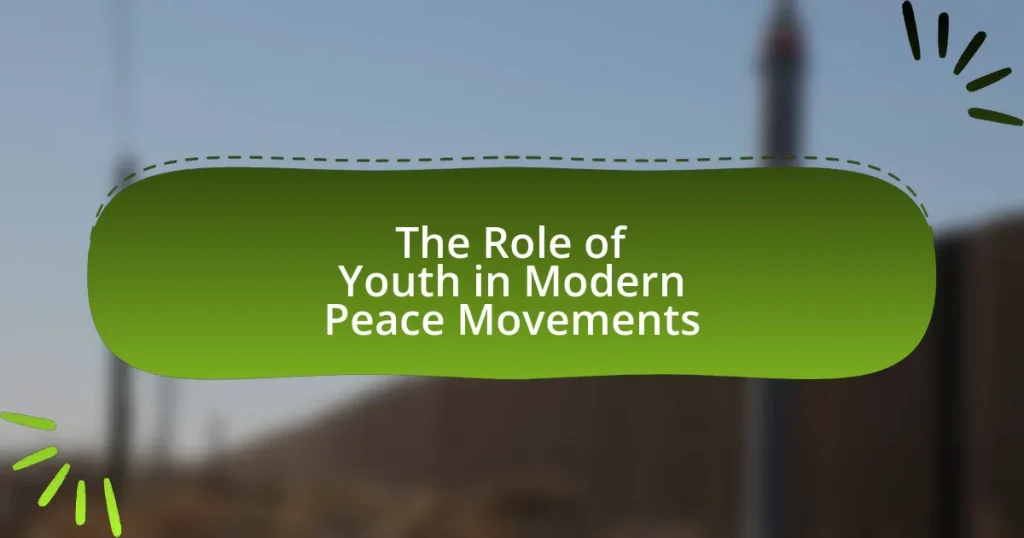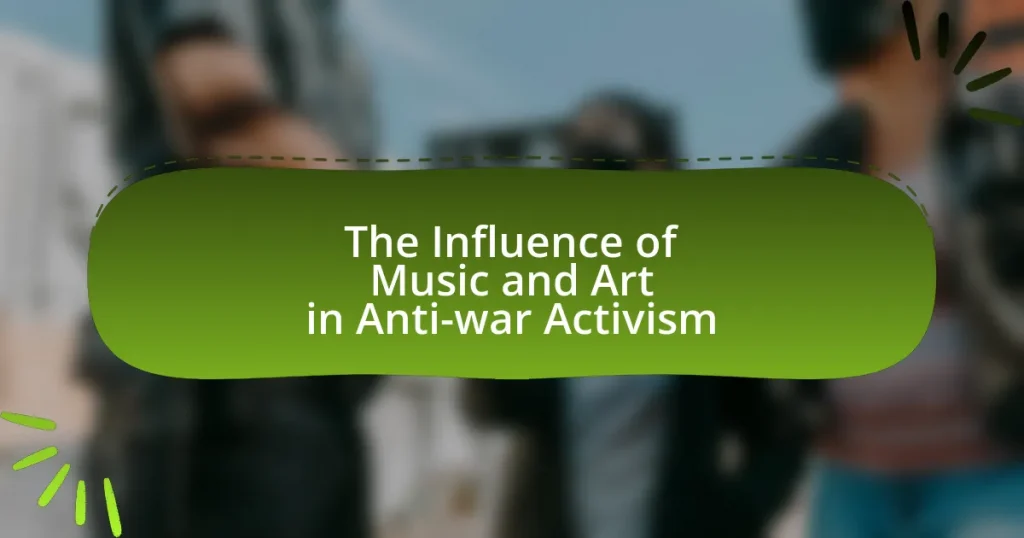Women have been pivotal in anti-war movements throughout history, serving as leaders, organizers, and advocates for peace. Their contributions have shaped the anti-war narrative by emphasizing the human costs of conflict and promoting diplomatic solutions. Notable figures such as Jane Addams and Rosa Parks exemplify women’s leadership, while contemporary activists continue to challenge militarism through grassroots organizing and coalition-building. The article explores the historical contexts of women’s activism, the challenges they face, and the strategies they employ to advocate for peace, highlighting the importance of recognizing women’s roles in shaping anti-war efforts.
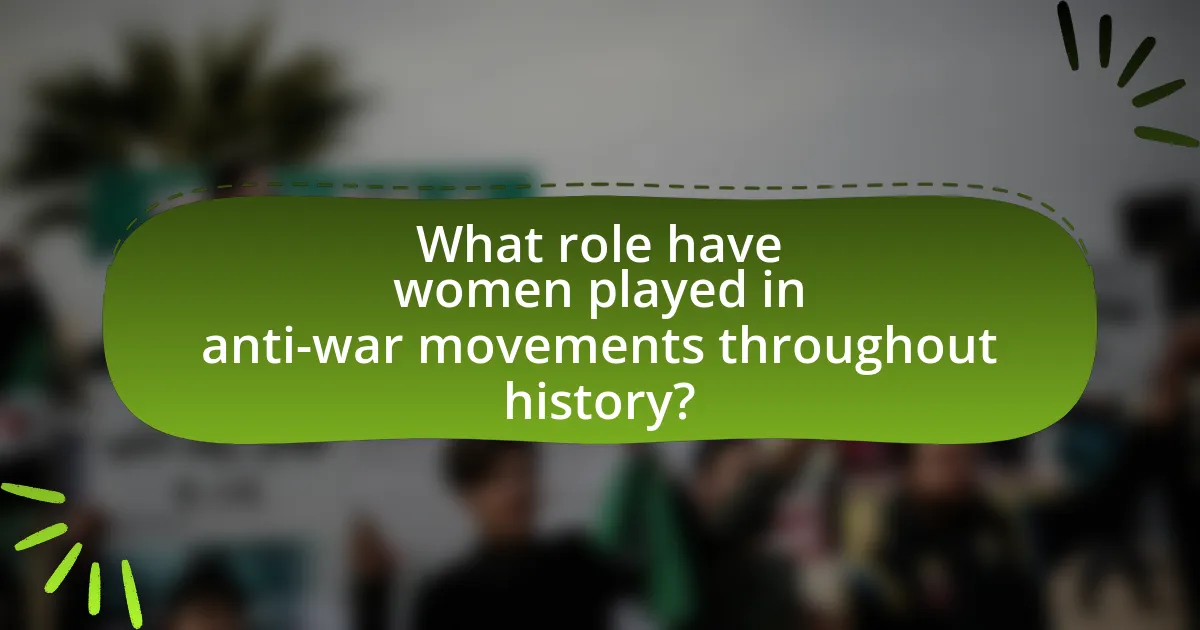
What role have women played in anti-war movements throughout history?
Women have played a crucial role in anti-war movements throughout history, often serving as leaders, organizers, and advocates for peace. For instance, during World War I, women formed organizations like the Women’s Peace Party in the United States, which was founded by prominent suffragists such as Jane Addams and Emily Greene Balch, who later received the Nobel Peace Prize for their efforts. In the 1960s, women were instrumental in the Vietnam War protests, with groups like the Women’s International League for Peace and Freedom mobilizing thousands to oppose military action. Their contributions have consistently highlighted the human cost of war and advocated for diplomatic solutions, demonstrating that women’s voices are vital in shaping peace movements.
How have women’s contributions shaped the anti-war narrative?
Women’s contributions have significantly shaped the anti-war narrative by introducing unique perspectives and mobilizing grassroots activism. Historically, women have organized protests, formed advocacy groups, and utilized their roles in society to challenge militarism and promote peace. For instance, during the Vietnam War, organizations like the Women’s International League for Peace and Freedom played a crucial role in raising awareness about the war’s human costs and advocating for diplomatic solutions. Additionally, women’s voices in literature and art have highlighted the emotional and social impacts of war, further influencing public opinion against military conflicts. These contributions have not only enriched the anti-war discourse but have also established women as vital leaders in peace movements throughout history.
What specific actions have women taken in various anti-war movements?
Women have engaged in various specific actions within anti-war movements, including organizing protests, forming advocacy groups, and participating in peace marches. For instance, during the Vietnam War, women organized the Women’s Strike for Peace in 1961, which mobilized thousands to advocate for nuclear disarmament and an end to the war. Additionally, women have played crucial roles in grassroots organizations, such as the Women’s International League for Peace and Freedom, founded in 1915, which continues to promote peace and disarmament globally. These actions demonstrate women’s significant contributions to anti-war efforts throughout history, highlighting their leadership and commitment to peace.
How have women’s perspectives influenced anti-war ideologies?
Women’s perspectives have significantly influenced anti-war ideologies by emphasizing the human cost of conflict and advocating for peace through empathy and community engagement. Historically, women have played crucial roles in anti-war movements, such as the Women’s Peace Party founded in 1915, which highlighted the devastating impact of war on families and communities. Their activism often centers on the moral and ethical implications of war, arguing that the suffering caused by violence outweighs any perceived benefits. This perspective has led to a broader understanding of security that includes social justice and human rights, as seen in movements like Women Strike for Peace during the Vietnam War, which mobilized thousands to protest against military actions. Women’s contributions have reshaped the discourse around war, making it more inclusive and focused on the consequences for civilians, thereby reinforcing the anti-war stance.
Why is it important to recognize women as pioneers in anti-war movements?
Recognizing women as pioneers in anti-war movements is crucial because it highlights their significant contributions and leadership roles in advocating for peace. Women have historically organized protests, formed influential groups like the Women’s International League for Peace and Freedom, and mobilized communities against militarism, demonstrating their vital impact on shaping public discourse around war. For instance, during the Vietnam War, women played a key role in protests, with organizations such as the Women’s Strike for Peace leading large demonstrations that influenced policy discussions. Acknowledging these contributions not only corrects historical narratives that often overlook women’s roles but also empowers future generations to engage in peace activism, reinforcing the idea that advocacy for peace is inclusive and multifaceted.
What historical contexts highlight women’s leadership in these movements?
Women’s leadership in anti-war movements has been prominently highlighted during key historical contexts such as World War I, the Vietnam War, and the Gulf War. During World War I, women organized the Women’s Peace Party in 1915, advocating for peace and disarmament, which showcased their ability to mobilize and influence public opinion. In the Vietnam War era, figures like Jane Fonda and the Women’s International League for Peace and Freedom emerged as significant leaders, challenging U.S. military involvement and emphasizing the human cost of war. The Gulf War saw women activists, including those from the Coalition for Peace and Justice, rallying against military action, further solidifying their role in peace advocacy. These contexts illustrate how women have consistently taken leadership roles in anti-war movements, shaping discourse and policy through organized efforts and public demonstrations.
How have women’s roles evolved in response to different wars?
Women’s roles have evolved significantly in response to different wars, transitioning from traditional domestic responsibilities to active participation in various capacities. During World War I, women entered the workforce in unprecedented numbers, taking on roles in factories and as nurses, which laid the groundwork for future involvement in public life. In World War II, women’s contributions expanded further as they served in military auxiliary units and took on leadership roles in anti-war movements, advocating for peace and social justice. The Vietnam War saw women organizing protests and forming coalitions, emphasizing their voices in political discourse. This evolution reflects a broader societal shift, where women increasingly challenge gender norms and assert their agency in both wartime and peacetime contexts. Historical evidence, such as the establishment of organizations like the Women’s International League for Peace and Freedom in 1915, illustrates women’s growing influence in anti-war efforts and their commitment to advocating for peace.

Who are some notable women leaders in anti-war movements?
Notable women leaders in anti-war movements include Jane Addams, who co-founded the Women’s International League for Peace and Freedom in 1915, advocating for peace during World War I. Another significant figure is Barbara Lee, a U.S. Congresswoman who has consistently opposed military interventions and was the only member of Congress to vote against the Authorization for Use of Military Force after the September 11 attacks in 2001. Additionally, Medea Benjamin, co-founder of the anti-war organization Code Pink, has been a prominent voice against U.S. military actions in various conflicts since the early 2000s. These women have played crucial roles in shaping public discourse around war and peace.
What impact did figures like Jane Addams and Rosa Parks have on anti-war efforts?
Jane Addams and Rosa Parks significantly influenced anti-war efforts through their activism and advocacy for peace and social justice. Jane Addams, a co-founder of the Women’s International League for Peace and Freedom, actively campaigned against World War I and promoted pacifism, emphasizing the need for diplomacy over military conflict. Her efforts included organizing peace conferences and advocating for women’s roles in peacebuilding, which helped to mobilize public opinion against war.
Rosa Parks, known for her pivotal role in the Civil Rights Movement, also contributed to anti-war sentiments by linking civil rights struggles with anti-war activism. Her participation in the 1967 “March Against the Vietnam War” highlighted the intersection of racial injustice and militarism, encouraging a broader coalition of activists to oppose the Vietnam War. Parks’ actions underscored the moral imperative to resist war as part of the fight for equality and justice.
Both figures exemplified how women’s leadership in social movements could shape public discourse on war, making their contributions vital to the anti-war efforts of their respective eras.
How did Jane Addams advocate for peace during World War I?
Jane Addams advocated for peace during World War I by co-founding the Women’s Peace Party in 1915 and later serving as the president of the International Congress of Women in The Hague in 1915. She actively promoted diplomacy and negotiation over military conflict, emphasizing the need for women’s voices in peace efforts. Addams organized peace conferences and called for disarmament, arguing that war was detrimental to society and that women had a unique role in fostering peace. Her efforts were recognized when she was awarded the Nobel Peace Prize in 1931, highlighting her significant contributions to the peace movement during the war.
What role did Rosa Parks play in the civil rights movement’s anti-war stance?
Rosa Parks played a significant role in the civil rights movement’s anti-war stance by advocating for peace and social justice. Her activism extended beyond racial equality; she was a vocal opponent of the Vietnam War, believing that the war disproportionately affected marginalized communities. Parks participated in anti-war demonstrations and aligned herself with organizations that opposed militarism, such as the Southern Christian Leadership Conference (SCLC). Her commitment to nonviolent resistance and social change reinforced the intersectionality of civil rights and anti-war efforts, highlighting the need for a unified approach to combat both racism and militarism.
Which contemporary women are leading anti-war initiatives today?
Contemporary women leading anti-war initiatives today include Medea Benjamin, co-founder of CodePink, and Malala Yousafzai, an advocate for peace and education. Medea Benjamin has been instrumental in organizing protests against U.S. military interventions and promoting peace through grassroots activism. Malala Yousafzai, while primarily known for her advocacy for girls’ education, has also spoken out against war and violence, emphasizing the need for peaceful resolutions. Their efforts highlight the significant role women play in advocating for peace and opposing war globally.
What organizations are women currently leading in the fight against war?
Women are currently leading several organizations in the fight against war, including Women’s International League for Peace and Freedom (WILPF), Code Pink, and the Global Network Against Weapons and Nuclear Power in Space. WILPF, founded in 1915, focuses on disarmament and peacebuilding, advocating for women’s rights in conflict resolution. Code Pink, established in 2002, mobilizes women to advocate for peace and social justice, particularly opposing military interventions. The Global Network, formed in 1999, campaigns against militarization and promotes peaceful alternatives. These organizations exemplify women’s leadership in anti-war movements, actively engaging in advocacy, education, and grassroots mobilization to challenge militarism and promote peace.
How do modern women activists draw inspiration from historical figures?
Modern women activists draw inspiration from historical figures by studying their strategies, resilience, and achievements in advocating for peace and justice. For instance, activists often reference figures like Jane Addams, who co-founded the Women’s International League for Peace and Freedom, to emphasize the importance of grassroots organizing and diplomacy in anti-war efforts. Additionally, the writings and speeches of historical leaders such as Rosa Parks and Malala Yousafzai serve as motivational tools, illustrating the power of individual action in challenging systemic injustices. This connection to the past not only provides a framework for contemporary activism but also reinforces the continuity of women’s contributions to social movements throughout history.

What challenges have women faced in anti-war movements?
Women in anti-war movements have faced significant challenges, including marginalization within the movements, societal gender biases, and limited access to leadership roles. Marginalization often occurs as women’s contributions are overlooked or minimized compared to their male counterparts, leading to a lack of recognition for their efforts. Societal gender biases further complicate their involvement, as traditional gender roles can discourage women from participating in activism or being taken seriously in their advocacy. Additionally, women frequently encounter barriers to leadership positions within these movements, which can hinder their ability to influence decision-making processes. Historical examples, such as the Women’s Peace Party founded in 1915, illustrate these challenges, as women activists struggled for visibility and authority in a predominantly male-dominated landscape.
How have societal perceptions of women affected their activism?
Societal perceptions of women have significantly influenced their activism by both empowering and constraining their roles within movements. Historically, women have often been viewed as caretakers and peacemakers, which has allowed them to position themselves as moral authorities in anti-war movements, leveraging these perceptions to advocate for peace and social justice. For instance, during the Vietnam War, organizations like Women Strike for Peace utilized the societal view of women as nurturers to challenge militarism and promote disarmament, effectively mobilizing large numbers of women who felt compelled to act against war. Conversely, these same perceptions have also limited women’s activism by reinforcing traditional gender roles that prioritize domestic responsibilities over public engagement, often sidelining their contributions in broader political discourse. This dual impact illustrates how societal views can both facilitate and hinder women’s activism in anti-war contexts.
What barriers have women encountered in gaining recognition for their efforts?
Women in anti-war movements have encountered significant barriers in gaining recognition for their efforts, primarily due to systemic gender biases and societal stereotypes. These biases often lead to the marginalization of women’s contributions, as their roles are frequently overshadowed by their male counterparts. For instance, research indicates that women activists are often relegated to supportive roles rather than being acknowledged as leaders, which diminishes their visibility and impact. Additionally, cultural perceptions that associate leadership and authority with masculinity further hinder women’s recognition in these movements. Historical examples, such as the exclusion of women from key decision-making positions in organizations like the Vietnam War protests, illustrate how these barriers have persisted over time, limiting women’s acknowledgment and influence in anti-war activism.
How have intersectional issues impacted women’s participation in anti-war movements?
Intersectional issues have significantly impacted women’s participation in anti-war movements by creating barriers based on race, class, sexuality, and other identities. For instance, women of color often face additional challenges compared to their white counterparts, as seen in the experiences of Black women in the civil rights and anti-war movements, who had to navigate both racial and gender discrimination. Research indicates that these intersectional identities can lead to differing priorities and experiences, which may result in marginalized voices being overlooked within predominantly white feminist spaces. This dynamic has historically limited the inclusivity and effectiveness of anti-war efforts, as highlighted by the work of activists like Angela Davis, who emphasized the need for a more intersectional approach to activism.
What strategies have women used to overcome these challenges?
Women in anti-war movements have employed various strategies to overcome challenges, including grassroots organizing, coalition building, and leveraging media for advocacy. Grassroots organizing allows women to mobilize communities, create networks, and foster local support, which has been essential in movements like the Women’s Peace Party founded in 1915. Coalition building with other social justice groups has enabled women to amplify their voices and address intersecting issues, as seen in the collaboration between anti-war activists and civil rights organizations during the Vietnam War era. Additionally, women have effectively utilized media, such as pamphlets, public speeches, and social media platforms, to raise awareness and influence public opinion, exemplified by the impact of the Women’s March in 2017, which highlighted anti-war sentiments alongside other social issues. These strategies have proven effective in challenging societal norms and advocating for peace.
How have women built coalitions to strengthen their anti-war efforts?
Women have built coalitions to strengthen their anti-war efforts by forming organized groups that unite diverse voices and perspectives against militarism. These coalitions, such as the Women’s International League for Peace and Freedom established in 1915, have facilitated collaboration among women from various backgrounds, enabling them to share resources, strategies, and mobilization tactics. Historical examples include the 1960s anti-Vietnam War protests, where women’s groups like the Women’s Strike for Peace played a crucial role in advocating for peace through grassroots activism and public demonstrations. These coalitions have effectively amplified women’s voices in the anti-war movement, leading to significant political influence and policy changes.
What role does education and awareness play in women’s activism?
Education and awareness are crucial in women’s activism as they empower women to understand their rights and mobilize for social change. Through education, women gain knowledge about political, social, and economic issues, enabling them to advocate effectively for their communities. For instance, studies show that educated women are more likely to participate in activism, as they can articulate their demands and challenge injustices. Awareness campaigns, such as those led by organizations like Women for Women International, highlight the impact of war on women, fostering solidarity and collective action. This combination of education and awareness not only informs women about their rights but also inspires them to take action, leading to significant advancements in gender equality and peace initiatives.
What can we learn from the history of women in anti-war movements?
The history of women in anti-war movements teaches us that women have played crucial roles as leaders and organizers, often challenging societal norms and advocating for peace. For instance, during the Vietnam War, women such as the members of the Women’s International League for Peace and Freedom mobilized protests and raised awareness about the consequences of war, demonstrating their capacity to influence public opinion and policy. Additionally, the involvement of women in these movements highlights the intersectionality of gender and peace activism, as they often address broader social issues, including civil rights and economic justice, thereby enriching the anti-war discourse. This historical context underscores the importance of inclusive leadership in peace movements, showing that diverse voices can drive significant change.
How can current and future activists apply these lessons?
Current and future activists can apply the lessons from women in anti-war movements by emphasizing collaboration, grassroots organizing, and intersectionality in their strategies. Historical examples, such as the Women’s Peace Party founded in 1915, demonstrate the effectiveness of uniting diverse groups to advocate for peace. Additionally, activists can learn from the leadership styles of figures like Jane Addams, who prioritized community engagement and social justice, showing that inclusive approaches can mobilize broader support. By adopting these principles, activists can create more resilient and impactful movements.
What best practices can be adopted from women’s historical activism?
Best practices that can be adopted from women’s historical activism include grassroots organizing, coalition-building, and the use of nonviolent protest strategies. Grassroots organizing, exemplified by the Women’s Peace Party founded in 1915, emphasizes local engagement and mobilization to address broader issues. Coalition-building is evident in the collaboration between various women’s groups during the suffrage movement, which strengthened their collective voice and impact. Nonviolent protest strategies, as demonstrated by women in the anti-nuclear movement, effectively draw attention to issues while maintaining moral high ground. These practices have historically led to significant social change and can be applied to contemporary activism for sustained impact.
